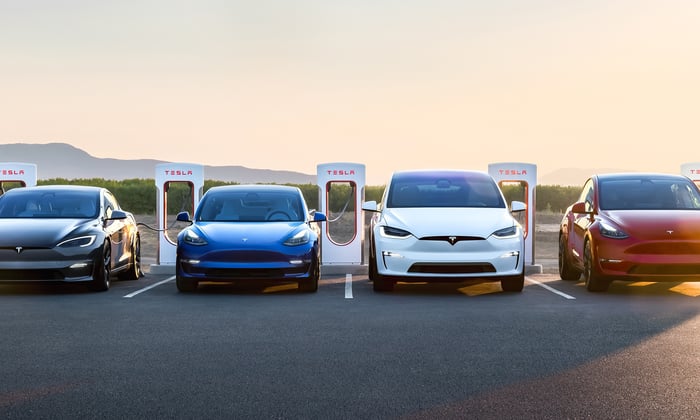Tesla to Launch Robotaxi Service Amid Competition from Uber and Waymo
Tesla (NASDAQ: TSLA) is set to introduce its robotaxi service in Austin this summer. This venture will utilize a fleet of Tesla-owned vehicles equipped with the first version of its unsupervised Full Self-Driving (FSD) software.
In a competitive landscape, Tesla will not operate in isolation. Uber (NYSE: UBER) riders may also encounter autonomous vehicles from Alphabet‘s (NASDAQ: GOOG) (NASDAQ: GOOGL) Waymo through a partnership between the two firms. Uber’s CEO, Dara Khosrowshahi, has issued a caution regarding Tesla’s independent approach.
Where to invest $1,000 right now? Our analyst team just revealed what they believe are the 10 best stocks to buy right now. Learn More »
“Demand often is quite variable,” Khosrowshahi stated at a recent conference. This variability prompts even industry giants like Alphabet, which can invest heavily in autonomous vehicle technology, to collaborate with ride-hailing services like Uber in various cities. Uber asserts it has effectively addressed the core challenges in launching an autonomous vehicle service.
Currently, much of Tesla’s stock value hinges on the success of its autonomous driving capabilities and ride-sharing services, according to various Wall Street analysts. Thus, Tesla faces a pivotal moment with its robotaxi launch this summer.

Image source: Tesla.
Key Challenges in Launching a Ride-Sharing Service
While it’s straightforward for Tesla to deploy a fleet of vehicles and create an app for users to request rides, effectively launching a ride-sharing service involves more complexities.
First, Tesla must stimulate demand for its service. Additionally, it faces supply-side challenges including pricing, fleet management, and routing vehicles to ensure accessibility to users across designated areas.
Fleet management poses particular risks. Although vehicles require significant investment, peak demand means that many will remain unused during off-peak hours. Tesla must commit considerable upfront capital, gambling on future demand to justify its fleet size.
On the flip side, if Tesla undersells its fleet and demand outpaces supply, users will experience frustrating wait times, potentially shifting to alternative services such as Uber.
Currently, Uber boasts about 171 million active users monthly—a number that exceeds its competitors, coupled with rapid growth. The company can enhance vehicle utilization rates by integrating human drivers and adjusting pricing dynamically to manage supply and demand effectively.
Moreover, Uber manages routing, pricing, and customer support, providing value that justifies its associated fees.
Implications for Tesla Investors
There are critical factors for Tesla investors to consider.
Khosrowshahi’s perspective as Uber’s CEO may not be impartial; it is unsurprising that he favors his company’s collaborative approach over Tesla’s standalone strategy.
Should Tesla invest adequately to deploy a fleet that meets high demand, it stands to benefit long-term. CEO Elon Musk is adept at generating excitement for Tesla products, attracting many fans eager to experience a ride in a Tesla, even if they cannot afford to purchase one.
However, this strategy carries significant risk, potentially greater than what investors currently recognize given Tesla’s stock price, which is trading at over 100 times projected earnings. This valuation reflects high expectations for Tesla’s anticipated earnings growth as its robotaxi service begins and expands.
In contrast, Waymo is adopting a more cautious strategy by testing its ride-sharing rollout across new cities and exploring various partnerships with Uber. In some locations, it will sell vehicles to Uber, granting that company full operational control. In others, Waymo will maintain ownership while employing the Uber app, while in select cities, it will provide rides through its app—mainly in areas with long-term testing.
This conservative approach allows Waymo to iteratively refine its economics for service expansion.
Tesla’s strategy is fraught with risks and potential rewards, but this is territory familiar to its shareholders.
A Valuable Investment Opportunity Awaits
Have you ever felt that you missed the chance to invest in hugely successful stocks? If so, you will want to stay informed.
Our team of analysts occasionally issues a “Double Down” Stock recommendation for promising companies, indicating it may be an opportune moment to invest. Should you feel you’ve missed your chance, consider now as the ideal time to act before it becomes too late. The statistics speak volumes:
- Nvidia: Invest $1,000 in 2009, and you’d have $323,920!*
- Apple: Invest $1,000 in 2008, and you’d have $45,851!*
- Netflix: Invest $1,000 in 2004, and you’d have $528,808!*
Currently, we are issuing “Double Down” alerts for three standout companies, and this may not be an opportunity that arises again anytime soon.
Continue »
*Stock Advisor returns as of March 3, 2025
Suzanne Frey, an executive at Alphabet, serves on The Motley Fool’s board of directors. Adam Levy has investments in Alphabet. The Motley Fool has positions in and recommends Alphabet, Tesla, and Uber Technologies. The Motley Fool maintains a disclosure policy.
The views and opinions expressed herein represent those of the author and do not necessarily reflect the opinions of Nasdaq, Inc.




